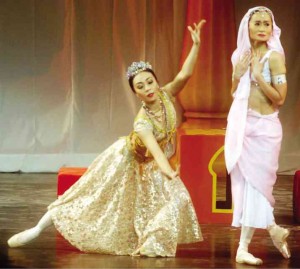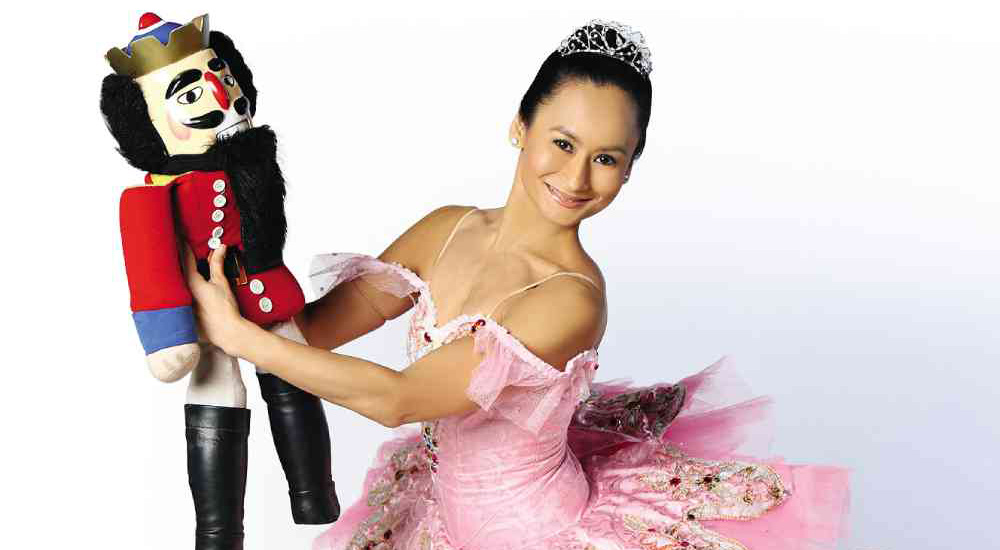
If you’ve been getting eyestrain from the “Yolanda” postings on Facebook and frustrated by news of unwieldy rescue and relief operations, it might be a good idea to get a quick fix at the theater. This month, the theater events are being purposeful.
Lisa Macuja-Elizalde, Ballet Manila’s resolute artistic director and prima ballerina, announced that proceeds of the ticket sales for “La Bayadere (The Temple Dancer)” will go to relief aid. This season, her “Swan Song Series” is one of her last hurrahs.
“Let me set the record straight: Yes, I am on the road to retirement. But no, I will not simply disappear without a trace. This phase will just signal a slowdown, taking on fewer appearances,” wrote the unstoppable Elizalde in the souvenir program.
“La Bayadere (The Temple Dancer)” is about a forbidden love affair between Nikiya, the dancer, and Solor, the warrior. Meanwhile, the Rajah of Golconda arranges a marriage between his daughter, Gamzatti, and Solor.
When Gamzatti learns of the love affair, she asks Nikiya to let go of Solor. An ensuing catfight leads to Nikiya attempting homicide. During the betrothal rites, Nikiya is asked to dance; unknown to her a poisonous asp has been planted in her prop. She is then bitten by the deadly snake. Distressed by Nikiya’s death, Solor retreats into opium which enables him to hallucinate to rejoin her in the Kingdom of the Shades or the next life.
Among the classics, the choreographic narration by Marius Petipa and V. Chabukiani has many loopholes and has very little relationship with its setting in India. Yet, it remains one of the popular pieces for its formula of flashy solos, vibrant character dancing and the mesmerizing ensemble work in the last act.
Strength and lyricism
In 1987, Elizalde’s debut in the title role in “La Bayadere” was met with critical acclaim. An artist-in-residence of Ballet Philippines, she was establishing her career in the Philippines after her stint with the Kirov. The ballerina, then 23 years old, wowed the audience with her steely strength and lyricism.

During her video sentimentally chronicling the evolution of her Nikiya, she acknowledged Rafael “Nonoy” Froilan, as her first Solor. Now a videographer, he was documenting her program.
Elizalde has since performed Nikiya in Russia in 1990 and with BM. Today, the 49-year-old dancer’s performance was still heavily applauded especially in her staccato boureés in her temple dance in Act One, and her swift traveling turns in her solo as a vision/spirit in Act Three.
Her costume revealed her waistline that was more sculpted and her abdomen that was more etched than her corps de ballet, who were a fraction of her age.
Obviously, the years of wear-and-tear and the surgeries showed in her a marked slowdown. Unlike her fearless, albeit reckless, dancing in her youth, she was more cautious and restrained—to keep her shelf life longer. But at midlife, she still has the strength and stamina to do successive full-length ballets that leave her fans enthralled.
Still, gradual decline of youthful power and elasticity has its tradeoffs. In the past, she would use every opportunity to flaunt her technical brilliance which sometimes led to slipshod results. Now, Elizalde’s performance was more heartfelt. There was that breath in dancing, a quality that’s hardly seen in the younger generation. Breath enables dancers to go through a rounded dynamic and an expressive range. It levels up dancing from technique into artistry.
The breath-phrasing textures filtered down from Elizalde down to soloists and corps de ballet.
As a mature artist, she reinvented herself as an influential personality in the local dance scene, as a producer and a multimedia talent.
Strong presence

In the gala night, Mikhail Martynyuk, the guest artist from the Kremlin Ballet with a strong stage presence, had the audience applauding when he entered the scene. As a tiger-slaying warrior, he played his part to the hilt; he executed his jumps with flair and his turns radiated vigor.
In the betrothal scene, his leaps were sharp and the circuit of the beaten jumps were crisp. He urgently punctuated his solos with his gracefully arched backbends on a kneeling position.
The danseur was a skillful partner to Elizalde and Mylene Aggabao, who played Gamzatti.
Previously, Aggabao, although technically gifted, tended to be too distant from her dancing. Here she was a flinty virtuoso who was fully committed to her role.
The ballet’s highlight was the descent of the female ensemble as Shades, moving down a ramp in a measured, zigzagging procession, one after another until they filled up the stage. Each dancer would hold their arabesque lines then bend back with their arms framing their faces. The repetition of these still poses is choreographically meant to suggest a dreamlike ambience.
The corps was commendably drilled, and with the Russian training shining through. However, it will probably take a few more performances before they achieve clockwork precision and that ethereal quality.
The three soloists—Dawna Mangahas, Joan Emery Sia and Jung Won Shin—lightened up the stage with elegance, scintillating speed and technical distinction.
BM’s overall production design could do some leveling up. But the costumes by Michael Miguel Albay, a student of Slim’s, were well-thought of.
Under the patronage of media baron Fred Elizalde, Ballet Manila has gone through great lengths to bring its performance to international standards. Russian conductor Alexander Vikulov was imported to lead the Manila Symphony Orchestra. It hired ushers in elegant barong Tagalog and came up with a classy souvenir program.
But there were rows of empty seats, despite the company’s aggressive publicity efforts. Still, there were many ordinary people who sat in the rafters and enthusiastically clapped. Elizalde had certainly lived up to her title as “Ballerina of the People.”













































